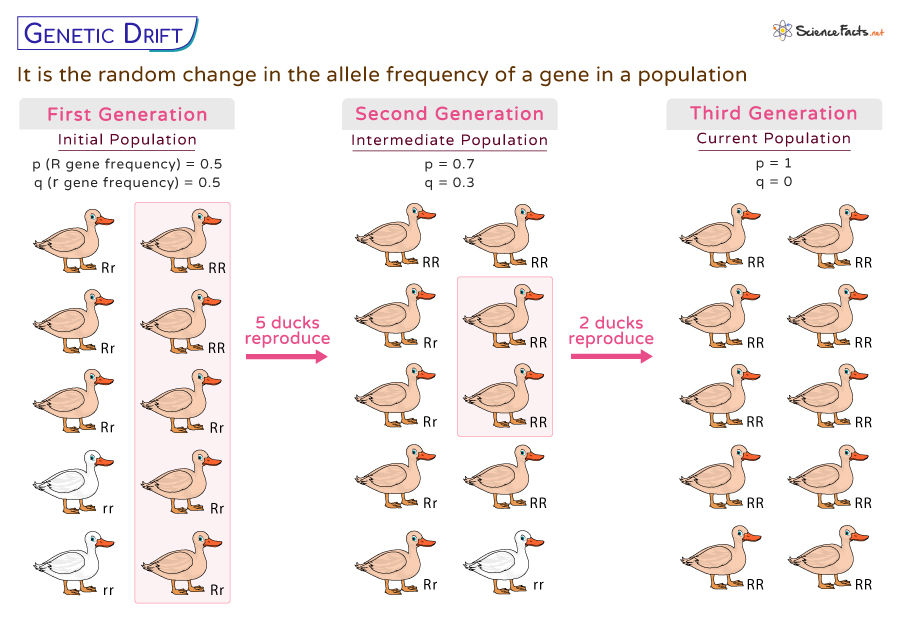Although random, genetic drift can have long-lasting effects on the genetic makeup of a population. The new population can be genetically distinct from the original group, which led to the hypothesis that genetic drift may form a new species. However, it does not bring adaptation to a population.
Types of Genetic Drift
Effects of Genetic Drift
Gene Flow vs. Genetic Drift
1. Bottleneck Effect
It occurs when a population undergoes a drastic reduction in size for at least one generation due to a catastrophic event like natural disasters (earthquakes, floods, and fires) or disease outbreak. With fewer individuals surviving the bottleneck, there is a high probability that certain alleles are lost, and others become overrepresented purely due to chance. Thus, it causes a loss of genetic diversity. Again, in a bottlenecked population, the surviving individuals are more likely to be homozygous for specific alleles, as fewer different alleles in the gene pool lead to homozygosity in the gene pool. As a result of this sudden and severe reduction, the surviving individuals may not represent the original genetic diversity of the population. Over time, as the population recovers, the genetic makeup reflects the limited diversity of the survivors, causing a genetic drift. If we remove a handful of marbles from a jar filled with different colored marbles, each representing a different allele, then the composition of the remaining marbles changes. It reflects the bottleneck in a population caused due to genetic drift. Here are a few examples of the Bottleneck effect found in nature. Examples
It is believed that the cheetah population experienced a significant reduction in numbers in the past decade or so, possibly due to changes in climate and habitat and interactions with other large predators. This reduction in population size led to a genetic bottleneck, a period during which the number of individuals in a species is sharply reduced, causing a significant loss of genetic diversity.The Northern Elephant Seal population experienced a severe bottleneck in the 19th century due to extensive hunting. The surviving population was reduced to a few dozen individuals, leading to a significant loss of genetic diversity. Although the population has since recovered, the effects of the bottleneck are still evident in their genetic makeup.
2. Founder Effect
It occurs when a small group diverges from a large population and establishes a new group in a different geographical area. The genetic makeup of this new group may not perfectly represent the diversity of the original population, leading to unique genetic characteristics in them. As the new population grows, it will carry the hereditary traits of the founders, leading to a unique genetic profile. The founder effect has many similarities with the bottleneck effect. However, the founder effect is caused by forming a colony (rather than a catastrophe). Examples
Pingelap Atoll in Micronesia provides a classic example of the founder effect. A typhoon in the 18th century dramatically reduced the population, and the survivors carried a high frequency of a gene causing color blindness. Today, a significant portion of the Pingelapese population has inherited this genetic trait, showcasing the lasting impact of the founder effect.As a subset of the sheep population was brought to the isolated island of Åland in the Baltic Sea, the Finnish landrace sheep (originally from Finland) experienced the founder effect. This founding group represented only a fraction of the genetic diversity of the broader Finnish landrace sheep population. Consequently, the Åland sheep population started with a limited set of genetic variants, which became the foundation for subsequent generations.
Increased Homozygosity in a Population
Genetic drift increases the frequency of homozygous individuals in a population. Homozygosity is found to occur when an individual possesses two identical alleles at a particular gene locus. As genetic drift reduces the number of alleles, individuals are more likely to inherit identical copies from their ancestors.
Loss of Beneficial Alleles and Fixation of Deleterious Alleles
Genetic drift in small populations can increase the risk of inbreeding, as closely related individuals may contribute disproportionately to the next generation. Inbreeding can cause the expression of recessive deleterious alleles and result in reduced fitness and health. Beneficial alleles might be lost, and deleterious alleles might become fixed purely due to chance factors. Gene flow, or migration, refers to the movement of genes or alleles between two different populations of the same species. It occurs when individuals from one population migrate and interbreed with individuals from another population. The movement occurs either physically or through the transfer of gametes (pollen, seeds, or spores). In contrast, genetic drift is the random change in the allele frequencies of a gene in a population due to chance events. It is more pronounced in smaller groups where random sampling can substantially impact allele frequencies. It is driven by random events, such as a population bottleneck or founder effect, which reduces the size of the population. While gene flow acts on a larger scale, influencing populations through the movement of individuals, genetic drift operates within populations, especially those of smaller sizes.
